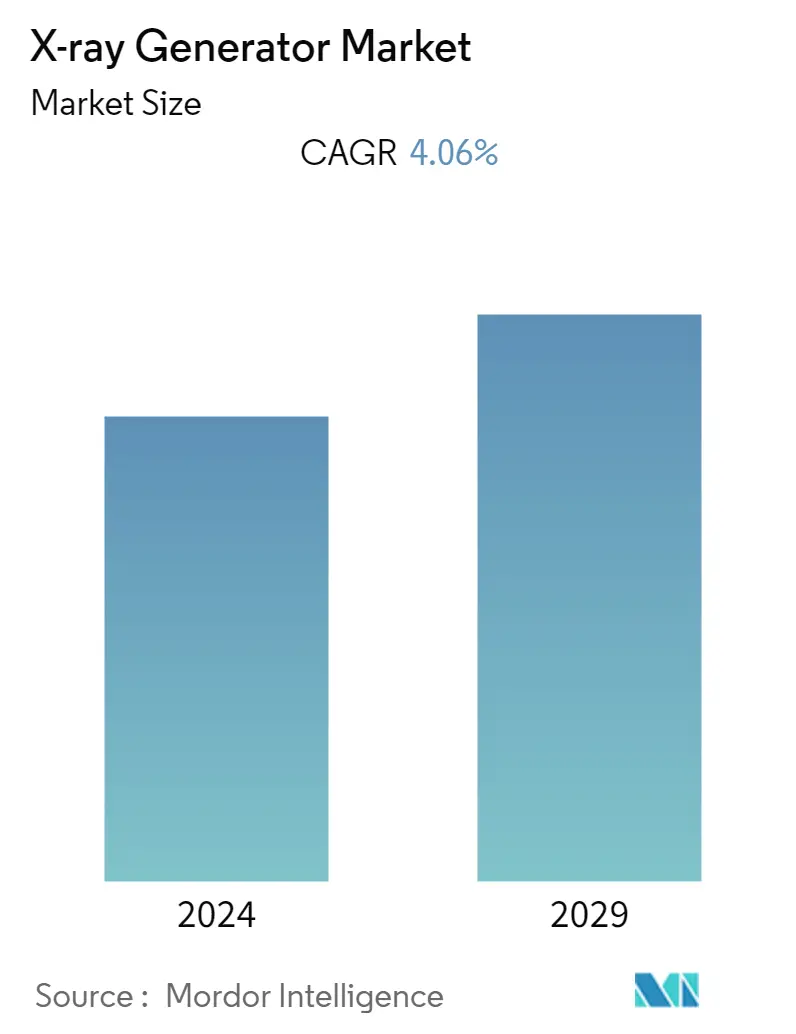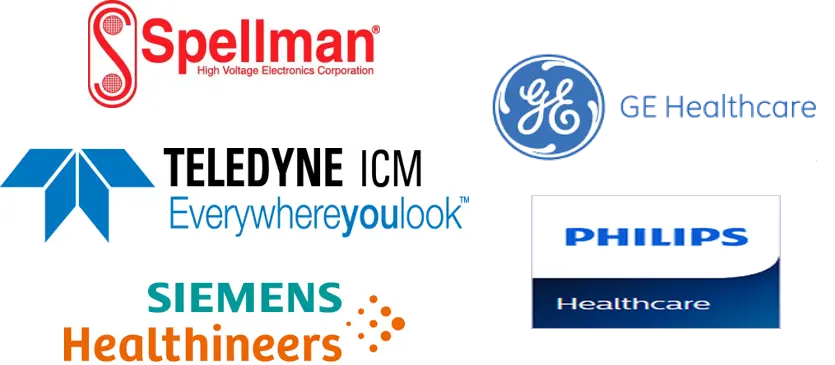Market Size of X-ray Generator Industry

| Study Period | 2019 - 2029 |
| Base Year For Estimation | 2023 |
| CAGR | 4.06 % |
| Fastest Growing Market | Asia Pacific |
| Largest Market | North America |
| Market Concentration | High |
Major Players
*Disclaimer: Major Players sorted in no particular order |
X-Ray Generator Market Analysis
The X-Ray generators market was valued at USD 450.99 million in 2020, and it is expected to reach USD 570.28 million by 2026, registering a CAGR of 4.06%, during the forecast period (2021 - 2026).
- X-Ray technology has been commonly associated with the healthcare and research and development sector for several years. However, in recent times, the technology has expanded into the manufacturing environments, which is helping several end-user industries improve the quality of production. Technological advancement is one of the primary factors driving the growth of the market.
- Aerospace and Defense are some of the primary industries that pioneered the use of X-ray inspection for quality control. Radiographic testing has been used successfully at Marshall Space Flight Center (MSFC) research center of the US government's civilian rocketry and spacecraft propulsion, for years to identify and characterize cracks, voids, inclusions, porosity, lack of weld penetration, lack of fusion in welds, and many other types of defects.
- Advances in medical imaging, primarily in computed tomography (CT) technology, have resulted in the rapid growth of X-ray examinations. Besides, the global geriatric population base at high risk of developing these chronic diseases is expected to stimulate the demand for high-resolution imaging systems.
- A pandemic like Covid-19 will only fuel the manufacturing of advanced medical devices and equipments to tackle such crisis in future. The increased production of healthcare devices will drive the X-Ray Generator market. For instance, GE Healthcare has recently announced to increase its manufacturing capacity for medical equipment including, CTs, ultrasound devices, mobile X-ray systems, patient monitors, and ventilators, to cater to the ongoing global challenge of treatments of COVID-19 patients.
X-Ray Generator Industry Segmentation
An X-ray generator is a device used to produce a high voltage to be applied between the anode and cathode. High voltage can be produced from a low-voltage, alternating current (AC) supply (the mains) using a transformer to give the waveform. The study analyses the penetration of x-ray generators across medical and industrial are considered under the scope of the market. Other types of end users such as law enforcement etc., are considered jointly analyzed under the industrial type of end user.
| Type | |
| Stationary Generators | |
| Portable Generators |
| End User | |
| Medical | |
| Indusrtial |
| Geography | ||||||
| ||||||
| ||||||
| ||||||
| Rest of the World |
X-ray Generator Market Size Summary
The X-ray generator market is experiencing significant growth, driven by advancements in technology and expanding applications across various industries. Traditionally associated with healthcare, X-ray technology has found new applications in manufacturing, particularly in aerospace and defense, where it is used for quality control through radiographic testing. The healthcare sector continues to be a major driver, with advances in medical imaging, especially in computed tomography, boosting the demand for X-ray examinations. The increasing global geriatric population and the need for high-resolution imaging systems further contribute to the market's expansion. Additionally, the COVID-19 pandemic has accelerated the production of advanced medical devices, including X-ray systems, to address healthcare challenges, thereby fueling market growth.
In the United States, the X-ray generator market is supported by a robust ecosystem of stakeholders, including component and system providers. Prominent companies like GE, Siemens Healthineers, and Spellman High Voltage Electronics Corporation are leading the market, focusing on integrating artificial intelligence with X-ray devices to enhance diagnostic capabilities. Regulatory standards in industrial applications also drive market demand, as compliance with testing regulations is essential for manufacturing and construction projects. The market is competitive, with major players expanding their global presence through strategic collaborations. Recent innovations, such as Philips' dual-purpose digital radiography-fluoroscopy system and Siemens' biplane angiography system, highlight the ongoing advancements in X-ray technology, further propelling market growth.
X-ray Generator Market Size - Table of Contents
-
1. MARKET INSIGHTS
-
1.1 Market Overview
-
1.2 Industry Value Chain
-
1.3 Industry Attractiveness - Porter's Five Forces Analysis
-
1.3.1 Bargaining Power of Suppliers
-
1.3.2 Bargaining Power of Buyers
-
1.3.3 Threat of New Entrants
-
1.3.4 Threat of Substitutes
-
1.3.5 Intensity of Competitive Rivalry
-
-
-
2. MARKET SEGMENTATION
-
2.1 Type
-
2.1.1 Stationary Generators
-
2.1.2 Portable Generators
-
-
2.2 End User
-
2.2.1 Medical
-
2.2.2 Indusrtial
-
-
2.3 Geography
-
2.3.1 North America
-
2.3.1.1 United States
-
2.3.1.2 Canada
-
-
2.3.2 Europe
-
2.3.2.1 United Kingdom
-
2.3.2.2 Germany
-
2.3.2.3 France
-
2.3.2.4 Rest of Europe
-
-
2.3.3 Asia Pacific
-
2.3.3.1 China
-
2.3.3.2 India
-
2.3.3.3 Japan
-
2.3.3.4 Rest of Asia-Pacific
-
-
2.3.4 Rest of the World
-
-
X-ray Generator Market Size FAQs
What is the current X-ray Generator Market size?
The X-ray Generator Market is projected to register a CAGR of 4.06% during the forecast period (2024-2029)
Who are the key players in X-ray Generator Market?
Spellman High Voltage Electronics Corporation, Siemens Healthcare Private Limited, GE Healthcare Inc., Teledyne ICM and Philips Healthcare Informatics Inc. are the major companies operating in the X-ray Generator Market.

